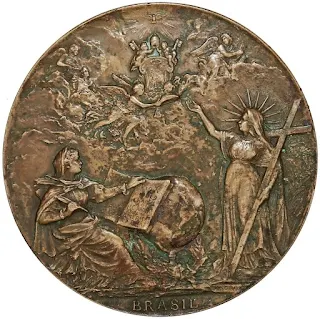Although he was born in Rome on November 23, 1855, Augusto Giorgio Girardet became one of the icons of Brazilian art. He initially studied with his father and later at the School of Fine Arts in Rome, where he had as teachers Francesco Podesti, Antonio Allegretti, and Giulo Monteverde. Girardet naturalized as a Brazilian around 1892, when his dedication and talent as a professor of medal engraving and precious stones at the National School of Fine Arts earned him significant admiration from the Brazilian people, especially from those in Rio de Janeiro. Despite being far from his homeland, he spent peaceful days in Rio de Janeiro, in his house in Copacabana, and is remembered as one of Brazil's most illustrious sons by scholars of numismatics.
The services he provided to the Brazilian Mint, where he was appointed a professor in 1912, deserve the highest accolades. He is particularly noted for the presidential series, composed of medals that feature, on the obverse, the effigy of the presidents of the republic, and on the reverse, a depiction of key government events. This series, of extraordinary value, is considered the most complete in the world of its kind and was exhibited along with other works at the National Museum of Fine Arts in November 1946, when Girardet was 91 years old.
For over 50 years, during which he received numerous commissions and accolades, Girardet recorded the official history of Brazil through his medals. He produced, among others, pieces for the Fourth Centenary of the Discovery of Brazil in 1900 (São Paulo, Paulista Museum) and for the National Exhibition of Rio de Janeiro in 1908, commemorating the opening of Brazilian ports to international trade. Others included medals for the visit of King Albert I of Belgium (1920), for the first centenary of Brazilian Independence (1922), for the inauguration of the great statue of Christ the Redeemer on Corcovado in 1931, and for the first centenary of the Dom Pedro II School (1935). He is also responsible for the 14 medals of the Brazilian presidential series, from the one of the first president, Deodoro da Fonseca (1889), to that of Eurico Gaspar Dutra (1950). A bronze series is housed in the Boncompagni Museum of Decorative Arts in Rome. In addition to his Brazilian productions, his works for Italy are also noteworthy.
In 1901, Girardet executed a medallion (21.5 cm in diameter) featuring the portrait of Giuseppe Verdi on the obverse and an allegorical representation of the composer's works on the reverse, donated to the Verdi Rest Home in Milan. This piece is currently in the Alla Scala Theater Museum (Verdi Room). In 1930, he created the medal for the marriage of Giovanna of Savoy and Boris of Bulgaria. There is a catalog titled “Retrospective Exhibition of Augusto Girardet by his disciples and continuators,” but this work is quite old and extremely rare. Additionally, I highlight my favorite piece by Girardet: the medal honoring Pius X, which can be appreciated in the following image.
Augusto began his career in engraving medals and precious stones under the guidance of his father, Antônio Giorgio Girardet, known as the “Eternal Father of Italian Engravers.” His family comprises artists, including sculptors, engravers, and painters.
When this incredible artist passed away in 1955, his personal collection, which contained original pieces and some of his last works, was sought after by dozens of national and international collectors. However, his intentions were thwarted when his widow, Mrs. Judith, sold the entire collection to the National Historical Heritage for 1 million cruzeiros. His collection was subsequently titled "Collection of the Patriarch of Engraving in Brazil."
Finally, I make a request: If anyone possesses the catalog mentioned in this article, I would appreciate it if you could kindly scan or photograph it so we can share it with other numismatists in Brazil. Additionally, it would be interesting to translate it into English so that more people around the world can learn about Girardet's work.
.png)





![[BR] Estados de conservação das moedas para classificação](https://blogger.googleusercontent.com/img/b/R29vZ2xl/AVvXsEgngHUbwbzQWgdpvGFsGk6Nrt0Go6jxcbHKC6V5SDagFKlXkXHss9q5-kDv25wU77PANGSBYEV4x2WjDUp36rXXea6fqEto7nrwXlkC61oKkLfgDJA_VWVWAs3y0T2Xh2Ycjfyb9mXm3DFPGD7S4h-8xJ3-Afgd88EJsTK8dCNpGWh0nxyyFqcmMevYDGg/w72-h72-p-k-no-nu/grading-scale.webp)
![[BR] Moedas raras despertam interesse e giram R$ 31 milhões](https://blogger.googleusercontent.com/img/a/AVvXsEikjc_mN6_3Oxkxi7yuMq84iwOdHmFPtJ87IAep_XZAAU877yon-_hYI-yDDJvHnF8P_ZhUz_xSn_bgl1Ik8wUFWbtIZ-Oh7hb3C2GPg0ySDGRgxvDhgQB-vNb14Ik9yg71TehGQSdJt7_Mzr_DFGjC6YFiwD3D-Ei0OGo0eCOLBpls5Zmfcdsv4ysgCt0=w72-h72-p-k-no-nu)
![[BR] Homenagem do CFB à Francisco Carlos de Araújo Brusque](https://blogger.googleusercontent.com/img/b/R29vZ2xl/AVvXsEjiiDp7QXyUO8_0EPynUiS6EOaWFAX7ztqd_1Xloaqi9uPSAjHQk8juCylId_u9O38HS45LVY997Dt_zZsf2DkX4iqLQWu6KUrtxHSWgtKlzO6jToNA1_Pd12rNVKcuVhNoAkXJpRcoh4Foy-IPsIaVhBlkvXFs1eWvYcRPNeBQ9_SiB8pP52YrXpjaOEw/w72-h72-p-k-no-nu/111.jpg)
![[ES] El BC reutilizó billetes antes de lanzar el billete de R$200.](https://blogger.googleusercontent.com/img/b/R29vZ2xl/AVvXsEhUq4eYbc4RMt5XC1nGZCR3e2o_cFzEaRQUt3LWe646UKxpObeYsaZwt2vY628Fd7fH1WcPtp60YiH-FMtoItjzQ-Yc-epPAFC3WanL9aZcNZ397MHN1cWo2u54LYn9q8HJyKv_onOM5ClTt_I-aAwYr0QJeo9EQYSyaNulaS1v0-8fWrfJb074f6r_UUA/w72-h72-p-k-no-nu/Sem%20t%C3%ADtulodasdas.jpg)

0 Comentários